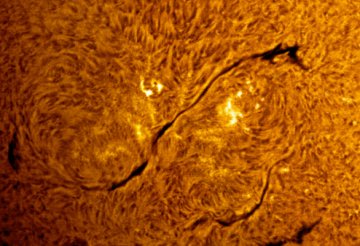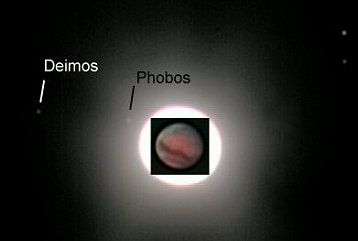 Would you like a call when the space station orbits over your backyard? Sign up for SpaceWeather PHONE.
Would you like a call when the space station orbits over your backyard? Sign up for SpaceWeather PHONE.
SOLAR SOUNDS: Who says the sun is quiet? Yesterday, Thomas Ashcraft of New Mexico, heard it making "swoosh" noises.
 Ashcraft is an amateur astronomer with a shortwave radio telescope. On Oct. 12th he tuned his receiver to 18.7 MHz and pointed the antenna at the sun. Although solar activity was supposedly low--yesterday we claimed the sun was "quiet"--he recorded some loud radio bursts: listen.
Ashcraft is an amateur astronomer with a shortwave radio telescope. On Oct. 12th he tuned his receiver to 18.7 MHz and pointed the antenna at the sun. Although solar activity was supposedly low--yesterday we claimed the sun was "quiet"--he recorded some loud radio bursts: listen.
The source of these emissions was, apparently, old sunspot 798. Last month, sunspot 798 was enormous and very active. Did you see the auroras of Sept. 11th? Those were caused by sunspot 798.
Since then the 'spot has decayed. All that's left is a dark filament separating two vast regions of weak positive and negative magnetism:

Sunspot 798 on Oct. 8th. Credit: Gary Palmer of Los Angeles.
This "ghost" of sunspot 798 is incapable of strong solar flares, but still capable of radio bursts. Compared to flares, radio bursts are low-energy; even a ghost can produce them. Will sunspot 798 "swoosh" again? Stay tuned.
FEAR AND PANIC: The two moons of Mars, Phobos and Deimos (Greek for Fear and Panic), are easy to overlook. They're tiny, less than 22 km wide, dim and rarely seen through a telescope. Mars itself shines 242,000 times brighter than Phobos and 741,000 times brighter than Deimos. The two moons get lost in the glare.
Nevertheless, it is possible, with effort, to photograph Phobos and Deimos. Steve Bodin of Mattawa, Washington, did it on October 10th:

"This is a composite of two exposures: a short exposure for Mars and a longer one to capture the faint moons," says Bodin, who used a 16-inch telescope and a color video camera. "Note the two 12th-magnitude stars visible to the upper right of Mars."

